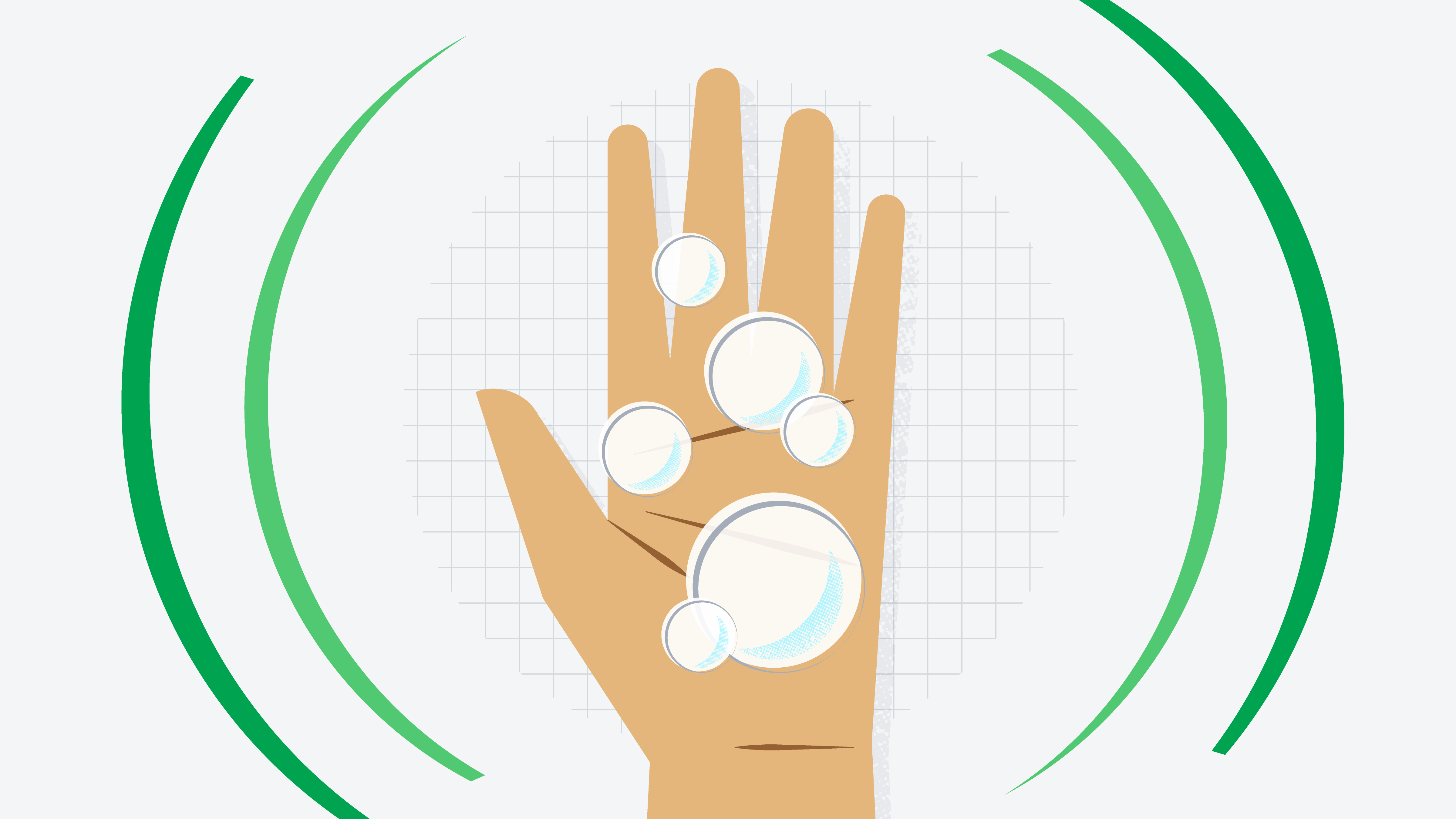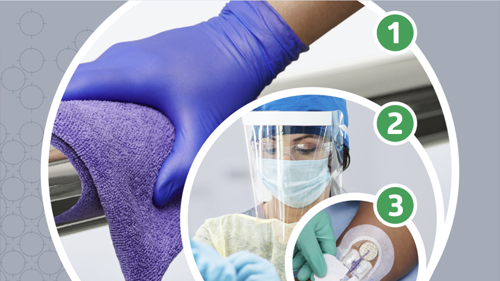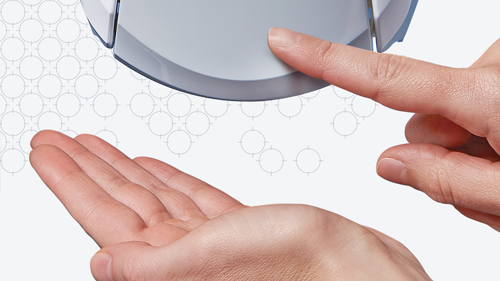Using electronic hand hygiene monitoring: Learn the benefits
6 studies reveal that electronic monitoring systems do increase hand hygiene compliance.

The year 2021 may turn out to be a watershed year for hand hygiene (HH). The emergence of COVID-19 infections has created an ultra-heightened awareness of the importance of handwashing. Then there were the 2021 changes in the Leapfrog HH Standard1, which now requires:
- Up to 200 direct observations per unit per month or
- The use of a validated electronic monitoring system to achieve the standard on the way to a top Leapfrog Safety Grade and eligibility for Leapfrog’s Top Hospitals Award
These events among other drivers have led many healthcare organizations to evaluate electronic hand hygiene compliance monitoring systems (EHHCMS) to accurately and reliably measure HH compliance. Naturally, this leads to the key question being asked by C-suite leadership: “Is the juice worth the squeeze?”
To answer that question, we turn to six studies published over the past seven years. By no means is this a meta-analysis of all studies but a sound cross-section of the available research. For a comprehensive look at all research in the category of EHHCMS, turn to PubMed.2
The year 2021 may turn out to be a watershed year for hand hygiene.
We hope the following studies help infection preventionists and quality leaders answer that return on investment (ROI) question when seeking funding for an EHHCMS. We all want to improve staff HH performance, knowing this will help reduce the risk of avoidable harm and healthcare-associated infections (HAIs), enhance patient/resident safety culture and eliminate incremental costs associated with HAIs.
1
Srigley, et al. (2014). Quantification of the Hawthorne effect in hand hygiene compliance monitoring using an electronic monitoring system.3
The Hawthorne effect refers to the reality that people behave differently when they’re aware that they’re being observed. This interesting study demonstrated how the Hawthorne effect hinders the accuracy of direct observation (DO) as a means to measure HH compliance.
A real-time tracking system was used to determine if a healthcare worker was in the line of sight of an observer conducting HH audits. When the healthcare workers could see the observer, they were about three times more likely (90% compliant) to perform HH compared with when they could not see the observers (30% compliant)—a Hawthorne effect of 300%. The study was conducted in Toronto where HH rates are reported publicly; this overstatement of HH compliance was reported by the Toronto Star with the headline, “Ontario hospital staff not washing hands as often as reported.”4
One of the investigators, Dr. Michael Gardam, then the Toronto University Health Network’s director of infection prevention and control, is quoted in the Toronto Star as saying, “We’re fooling ourselves. The numbers that we are getting and we are posting publicly are not real, they’re artificial.”
2
Kelly, et al. (2016). Electronic hand hygiene monitoring as a tool for reducing healthcare-associated methicillin-resistant Staphylococcus aureus infection.5
Dr. William Kelly and colleagues at Greenville Memorial Hospital in Greenville, S.C. (now part of Prisma Health), used an EHHCMS to demonstrate on a unit-by-unit basis that staff feedback based on system data was able to improve HH compliance by more than 25%. This action was associated with a reduction in MRSA infections of more than 42% and a cost avoidance by eliminating 24 MRSA infections of $434,000 per year, or $670 per bed per year.
Kelly further pointed out, “We show that electronic monitoring of HH can lead to clinically important organizational change and, most importantly, improved patient safety.”
3
Bouk, et al. (2016). Use of an Electronic Hand Hygiene Compliance System to Improve Hand Hygiene, Reduce MRSA, and Improve Financial Performance.6
Martha Bouk, then head of infection prevention at Riverside Medical Center in Kankakee, Ill., used an EHHCMS to achieve improvement on three metrics: HH compliance (39% improvement), MRSA infection rate (50% reduction) and economic improvement (their Affordable Care Act financial penalty was eliminated; multiple factors in addition to HH likely contributed to this).
The Hawthorne effect refers to the reality that people behave differently when they’re aware that they’re being observed.
4
Robinson, et al. (2014). Innovative Use of Electronic Hand Hygiene Monitoring to Control a Clostridium Difficile Cluster on a Hematopoietic Stem Cell Transplant Unit.7
Natasha Robinson, then an infection preventionist at Greenville Memorial Health System in Greenville, S.C., used EHHCMS data to provide staff feedback on HH behavior. Her goal was to drive higher compliance with the facility’s protocol of washing with soap and water versus using alcohol-based hand sanitizer in cases of Clostridium difficile infections (CDIs). The result was an increase in HH compliance from 77.4% to 93.9% (21.3% increase) and a drop in the CDI rate from 7.03/10,000 patient days to 2.38/10,000 patient days—a decline of 66%.
5
Banks and Phillips, 2021. Evaluating the effect of automated hand hygiene technology on compliance and C. difficile rates in a long-term acute care hospital.8
Maureen Banks and Andrew Phillips demonstrated a significant increase in HH compliance from 89.7% to 97.1% and a reduction in CDI rates from 9.54 to 3.72 infections per 10,000 patient days (61% decrease) in a long-term acute care hospital using an EHHCMS.
6
Kelly et al, 2016. Use of Targeted Solutions Tool (TST) and Electronic Monitoring to Improve Hand Hygiene Compliance (2016).9
Kelly and his team demonstrated a 23.5% improvement in HH by using EHHCMS for measurement of HH combined with using DO for coaching and feedback along with barrier and obstacle identification. John Boyce further embraced this model in his 2017 paper, “Electronic Monitoring in Combination with Direct Observation as a Means to Significantly Improve Hand Hygiene Compliance.”10
Various other studies support how an EHHCMS can play a significant role in improving HH compliance and reducing HAIs and their associated costs while positively influencing patient/resident safety culture. 2021 may be the inflection point for this technology’s evolution into best practice standard of care, just as alcohol-based hand rubs did in the past. An EHHCMS can be a powerful and effective addition to the arsenal used to fight HAIs and eliminate risk of avoidable harm.

VP Patient Safety Innovation for Medline Industries, LP
Paul invented the first electronic hand hygiene monitoring system designed to improve hand hygiene performance while reducing infections and costs. He is an innovative and mission-driven leader with more than 35 years of experience in hand hygiene and patient safety solutions. Paul also shared hand hygiene insights as a past contributor to Healthcare Hygiene Magazine.
Disclosure: Medline was a 2021 member of the Leapfrog Partners Advisory Committee and has a collaborative relationship with a company that offers electronic hand hygiene monitoring services.
References:
- Leapfrog Group. (2020, April 13). Leapfrog Hospital Survey. Retrieved from https://www.leapfroggroup.org/sites/default/files/Files/2020HospitalSurvey_20200413_8.1%20%28version%201%29.pdf
- PubMed (nih.gov).
- Srigley JA, Furness CD, Baker GR and Gardam M. Quantification of the Hawthorne Effect in Hand Hygiene Compliance Monitoring Using an Electronic Monitoring System: a Retrospective Cohort Study. (2014) BMJ Qual Saf. 23, 974-80.
- Ontario hospital staff not washing hands as often as reported: study | The Star.
- Kelly JW, Blackhurst D, McAtee W and Steed C. Electronic Hand Hygiene Monitoring as a Tool for Reducing Health Care Associated Methicillin-Resistant Staphylococcus aureus Infection. (2016) Am J Infect Control. 44(8), 956-957.
- Bouk M, Mutterer M, Schor M, Alper P. (2016) Use of an Electronic Hand Hygiene Compliance System to Improve Hand Hygiene, Reduce MRSA, and Improve Financial Performance. Am J Inf Control 44(6), Supplement, S100-S101, June 02, 2016. DOI:https://doi.org/10.1016/j.ajic.2016.04.135.
- Robinson N et al (2014) AJIC 42(6), Supplement, S150, June 01, 2014. DOI:https://doi.org/10.1016/j.ajic.2014.03.319
- Banks, M and Phillips, A.B. (2021) AJIC 49(6): 727-732. doi: 10.1016/j. ajic.2020.10.018.
- Kelly JW, Blackhurst D, Steed C, Boeker S, McAtee W. Use of Targeted Solutions Tool (TST) and Electronic Monitoring to Improve Hand Hygiene Compliance (2016) Accepted as a Poster for presentation at the 2016 SHEA Conference.
- Boyce JM. Electronic Monitoring in Combination with Direct Observation as a Means to Significantly Improve Hand Hygiene Compliance. (2017) Am J Infect Control. 45(5), 528-535.




